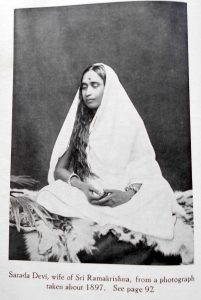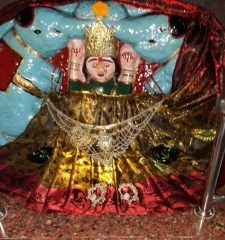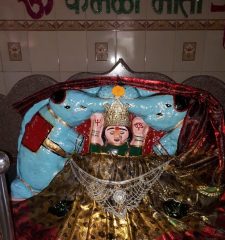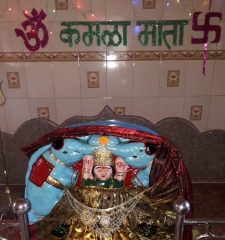The Kali Temple
The Kali Temple in Dudu, Dudu is a town located 63 kilometers from Jaipur, Rajasthan state, India.
This holy Kali idol is several hundred years old. There is a lot of rush of visitors to this temple on Saturdays and Sundays. It is therefore best to visit this holy temple on weekdays (non holidays).
These images of this holy Kali idol are published for the first time.
If Kali steps on Shiva with her right foot and holds the sword in her left hand, she is considered to be the form The Dakshina Kali.
If the Kali steps out with the left foot and holds the sword in her right hand, she is the terrible form of Mother, The Smashan Kali of the cremation ground. She is worshiped by tantrics, the followers of Tantra, who believe that one’s spiritual discipline practiced in a smashan (cremation ground) brings success quickly.
Kalighat Kali Temple
Kalighat Kali Temple is a Hindu temple in West Bengal, India dedicated to the Hindu goddess Kali. It is one of the 51 Shakti Peethas. Kalighat was a Ghat sacred to Kali on the old course of the Hooghly river in the city of Calcutta.
Kalighat is regarded as one of the 51 Shakti Peethas of India, where the various parts of Sati’s body are said to have fallen, in the course of Shiva’s Rudra Tandava. Kalighat represents the site where the toes of the right foot of Dakshayani or Sati fell.
The image of Kali in this temple is unique. It does not follow the pattern of other Kali images in Bengal. The present idol of touchstone was created by two saints – Atmaram Brahmachari and Brahmananda Giri based on the idol of Mata Bhubaneshwari,[11] the Kula Devi of the Sabarna Roy Choudhury family. Presently, the three huge eyes, long protruding tongue made of gold and four hands, which all are made of gold too. Two of these hands holding a scimitar and a severed head of the asura king ‘Shumbha’. The scimitar signifies Divine Knowledge and the asura (or, human) head signifies human Ego which must be slain by Divine Knowledge in order to attain Moksha. The other two hands are in the abhaya and varada mudras or blessings, which means her initiated devotees (or anyone worshiping her with a true heart) will be saved as she will guide them here and hereafter.
Bhagavan Sri Ramakrishna
Sri Ramakrishna Paramahansa (18 February 1836 – 16 August 1886,[1][2][3][4] born Gadadhar Chattopadhyaya,[5] was an Indian Hindu mystic, saint, and religious leader in 19th century Bengal.[6] Sri Ramakrishna experienced spiritual ecstasies from a young age, and was influenced by several religious traditions, including devotion toward the Goddess Kali, Tantra, Bhakti and Advaita Vedanta.[7][8] As a priest at the Dakshineshwar Kali Temple, his mystical temperament and ecstasies gradually gained him widespread acknowledgment, attracting to him various spiritual teachers, social leaders, and lay followers; he eventually taught disciples, who would later form the monastic Ramakrishna Order.[9] He was generally revered by Bengali elites and within religious circles, which led to his chief disciple Swami Vivekananda founding the Ramakrishna Math, which provides spiritual training for monastics and householder devotees and the Ramakrishna Mission to provide charity, social work and education.
Sri Ramakrishna Paramahansa had the direct Darshan of Goddess Kali, who appeared before him on several occasions.
See the movie The film – Bhagavan Sri Ramakrishna on youtube with English Subtitles.
Sarada Devi

Sarada Devi ; (22 December 1853 – 20 July 1920), born Kshemankari/ Thakurmani/ Saradamani Mukhopadhyay, was the wife and spiritual consort of Sri Ramakrishna, a nineteenth-century Hindu mystic and saint. Sarada Devi is also reverentially addressed as the Holy Mother (Sri Sri Maa) by the followers of the Sri Ramakrishna monastic order. Sri Sarada Devi or Sri Sri Maa is one of the notable woman saints and mystics of the nineteenth century. She paved the way for the future generation of women to take up monasticity as the means and end of life. In fact the Sri Sarada Math and Ramakrishna Sarada Mission situated at Dakshineshwar is based on the ideals and life of Sri Sri Maa. Sri Sarada Devi played an important role in the growth of the Ramakrishna Movement.
Sri Sarada Devi was born in Joyrambati. At the age of five she was betrothed to Sri Ramakrishna, whom she joined at Dakshineswar Kali temple when she was in her late teens. According to her biographers, both lived lives of unbroken continence, showing the ideals of a householder and of the monastic ways of life. After Sri Ramakrishna’s death, Maa Sarada Devi stayed most of the time either at Joyrambati or at the Udbodhan office, Calcutta. The disciples of Sri Ramakrishna regarded her as their own mother, and after their guru’s death looked to her for advice and encouragement. The followers of the Ramakrishna movement and a large section of devotees across the world worship Sri Sri Maa Sarada Devi as an incarnation of the Adi Parashakti or the Divine Mother Goddess Parvati.
In Hinduism, Kamala (Sanskrit: कमला) or Kamalatmika (Sanskrit: कमलात्मिका) is the Devi in the fullness of her graceful aspect. She is a form of Parvati as all Mahavidyas are. She is believed as the tenth Mahavidya (“great wisdom”)[1]. Her prayers pacify Shukra.
Kamalatmika has a golden complexion. She is being bathed by four large elephants, who pour kalashas (jars) of amrita (nectar) over her. She has four hands. In two hands, she holds two lotuses and her other two hands are in abhayamudra (gesture of giving assurance) and varamudra (gesture of conferring boons) respectively. She is shown as seated in padmasana (lotus posture) on a lotus,[1] symbol of purity.
“Tenth incarnation of Shambhu is known as ‘Kamala (कमल)’ the bestower of joy here and liberation hereafter; and GirijA’s manifestation there is called ‘kamalA (कमला)’ who takes all care of her devotees. These are the ten manifestations of Shiva and Shakti, the giver of happiness, bestower of material comforts here and liberation hereafter to their devotees”.












